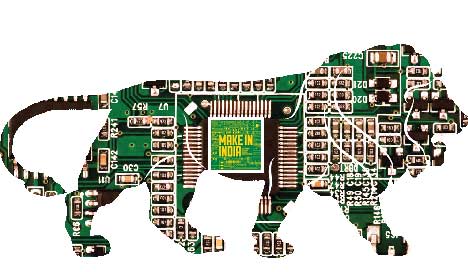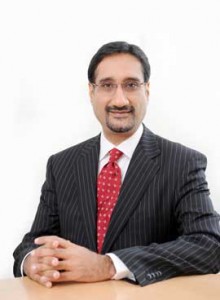India, today consumes close to $7 billion of semiconductor products every year. By 2020, when the total Electronic System Design and Manufacturing (ESDM) market is expected to reach $ 400 billion, this consumption is expected to rise to $55 billion. With the location of a fab in India, the country could potentially achieve a degree of self-sufficiency in electronics, and partially reduce the very high supply chain risks that India is exposed to, without an alternate source for procurement.
 The Indian semiconductor sector comprises pre-fabrication, fabrication and post fabrication verticals. The semiconductor segment can be divided into semiconductor designing, semiconductor manufacturing and semiconductor assembly testing mark pack (ATMP).
The Indian semiconductor sector comprises pre-fabrication, fabrication and post fabrication verticals. The semiconductor segment can be divided into semiconductor designing, semiconductor manufacturing and semiconductor assembly testing mark pack (ATMP).
![]() Semiconductors are used extensively in various applications, which offer immense potential for the growth of this industry in India. Semiconductors are used majorly in Mobile Devices, Telecommunications, Information Technology & Office Automation (IT & OA), Industrial, Automotive and other industries (Aerospace, Defense and Medical industries).
Semiconductors are used extensively in various applications, which offer immense potential for the growth of this industry in India. Semiconductors are used majorly in Mobile Devices, Telecommunications, Information Technology & Office Automation (IT & OA), Industrial, Automotive and other industries (Aerospace, Defense and Medical industries).
The Increasing spend on electronics products in India offers a large opportunity to global semiconductor companies to set up manufacturing plants in the country.
In the light of policy announcements for setting up two semiconductor fabrication facilities in India, the future looks promising for semiconductor manufacturing companies in India.
Clearly, with the economy improving in the country over the past couple of decades, the consumption of electronic goods has also increased. Today, electronics and semiconductors are so pervasive that every product has some portion of electronics and semiconductors. As our economy continues to grow in the future, the market for electronics and semiconductors will only grow in the country.
Despite this growth, the amount of development and manufacturing happening in our country is very limited. There was a lot of talk of a semiconductor fab but it did not happen. Even in other areas of the value chain where components, subsystems and systems are put together (integrated), there is very little happening to be proud about. With consumption forecasted to increase, it is expected that more and more of manufacturing would begin to happen.
Here we asked some industry leaders their thought of India semiconductor consumption, its growth rate and how it will influence manufacturing in India:
Som Pal Choudhury @ Analog Devices India

Electronics consumption in India is growing in double digits and so is semiconductor consumption. However, more than 65% of the electronics is currently imported, around 25-30% of the systems simply assembled and less than 10% of the electronic systems are completely designed and manufactured in India. In case of semiconductor, almost 100% is sourced from outside India as we do not have a Fab.
But India is a happening place for semiconductor design. Almost all semiconductor MNCs have significant amount of design activity from India. Multiple design houses are also either doing full chips or supporting the design activity of the MNCs. According to the Department of Electronics and Information Technology (DeitY), nearly 2,000 chips are being designed every year in India and more than 20,000 engineers are working on various aspects of chip design. There are more than 120 companies in India focused on semiconductor design for global products. This design industry has witnessed a robust growth of 17.3 per cent since 2009 and today boasts of a 5-10% share of the global pie.
We are seeing healthy demands in many of the market verticals including military and aerospace, process and industrial automation, automotive, energy, security and surveillance and communications infrastructure. A keen push for Make in India programs for the defense market, growing military offset business, preferential access for some government telecom procurement and automation for power plants and factories are all driving the growth. We expect more to come from the Make In India initiatives by the new government.
The demands from our customers are more system centric. Compact form factor, reliability, connectivity, energy efficiency, higher integration in terms of System on a Chip (SoC) or more importantly System in a Package (SiP) and more and more software including algorithms are requirements coming from our customers. While this has been the modus operandi for the consumer market for a long time, we see other market segments moving in that direction.
Internet of Things (IoT) while nascent today will have a big impact for the semiconductor industry. BLR IoT chapter is now under the guidance of India Electronics and Semiconductor Association (IESA) and Technology Indus Entrepreneurs (TiE) and a number of productive initiatives and sessions are underway.
Vinay Shenoy @ Infineon Technologies India
 As India revives from economic gloom of past few years we are witnessing a new segment with purchasing power. India’s ESDM market comprises of domestic demand and products manufactured for exports. According to a recent market research report, 100 percent of the semiconductors used in this market is presently imported and is estimated to worth $10 billion in 2013. As per Novonous report the semiconductor market in India is estimated to grow from $10 billion in 2013 to $52 billion in 2020 at CAGR of 26.72 percent.
As India revives from economic gloom of past few years we are witnessing a new segment with purchasing power. India’s ESDM market comprises of domestic demand and products manufactured for exports. According to a recent market research report, 100 percent of the semiconductors used in this market is presently imported and is estimated to worth $10 billion in 2013. As per Novonous report the semiconductor market in India is estimated to grow from $10 billion in 2013 to $52 billion in 2020 at CAGR of 26.72 percent.
Semiconductors are used extensively in various applications, which offer immense potential growth. India has a very large industry base of electronics items used extensively in Mobile Devices, Telecommunications, Information Technology & Office Automation, Industrial, Automotive, Aerospace, Defense and Medical devices. As per government data the import bill of electronic components is expected to cross the import bill of oil by 2020.
In the backdrop of a stable Indian economy and political environment, the main drivers for semiconductor growth will be mobile devices, telecommunications, IT and office automation and automotive electronics; spurred by younger generation of consumers with higher purchasing power.
Steps are also being taken by the government to encourage domestic production of electronic items. Policy initiatives like M-SIPS are some of the major initiatives taken by the Government of India to boost the Indian semiconductor industry and propel growth in the sector..
Gursharan Bhatia @ Littelfuse India

India Semiconductor consumption is growing @ 15% and is currently at 3.3 BUSD (passive components)
The main growth is driven by Telecommunication, consumer electronics and automotive electronics industries. Use of Internet and mobile phones is fuelling the overall growth coupled with change in government policies for electronics for example mandatory use of Set Top Box, LED lighting (specially street lights), rural ATM machines, EVMs Electronic Voting machines, Smart meters and other smart appliances which means more electronics.
Joseph Chiam @ Micrel Inc.

We are seeing the semiconductor consumption in India today to be around $1 Billion US, based on our estimate gathered from the key component suppliers and distributors. This does not account for CKD and we believe that some products might be categorized differently. However you look at it, this market is definitely growing.
India has a vast opportunity for product designs. With the government’s incentive to produce locally, we see this growth becoming more prominent as manufacturers are poised to bring in semiconductor components for production within India. We see key opportunities for products meant for local domestic consumption, replacement, etc., and thus, these are factors driving growth in India.
Spansion
We recognize it is growing drastically actually but a bit slow than originally expected. The growth markets are
- Electronic Power Meter (Smart Meter incl.) , Invertor Motor control function in Industrial Market.
- Invertor Motor control function in Home appliance (HVAC, Washing Machine)
- LED Lighting control
Jaswinder Ahuja @ Cadence

The growth of the industry and consumption of semiconductors in India are directly influenced by the consumer demand of electronic goods in the country. The India market is on a growth trajectory and this bodes well for the semiconductor industry. The India ESDM Market: IESA – Frost & Sullivan Report published in January 2014 notes that the country’s semiconductor industry will grow at a CAGR 9.9% and by 2015, is pegged to reach USD94.2 billion. This growth is expected to come from internal consumption, and from the building of domestic capabilities to serve both the local and the international markets.
The three key drivers of growth in India are the following:
Mobility: As is the case the world over, in India too, the growth of the electronics and semiconductor industry has largely been driven by the rise of the mobile platform
Consumer Demand / purchasing power: In the past two decades, following the opening of the economy and the concurrent growth of the IT industry, a prosperous middle class with a desire for world class technologies has emerged in India. The demand for electronics is not limited to urban centers. According to this HT Mint article Tier 2 and 3 cities also offer huge potential for various electronics devices.
Make in India: The “Make in India” initiative launched in September 2014 by the Government can have an impact on the semiconductor and electronics eco-system in India, though we are yet to see concrete evidence of it. The Government’s commitment to providing defined timelines for all clearances is likely to renew interests among investors. Further, as a part of the “Make in India” campaign, the Government is looking to provide further incentives by way of capital subsidies and attractive MSIPs packages. Following the announcement, the Government announced that they have received proposals to the tune of Rs 2,000 crores. This speaks to huge business opportunity to design and manufacture products for India, in India.
Pradeep Vajram @ SmartPlay

As per the Frost & Sullivan’s study on Indian ESDM market, the industry in India is expected to grow at a CAGR of 9.9 per cent to reach a turnover of US$ 94.2 billion by 2015. This is more than twice the growth rate of the global ESDM market and presents immense potential for the domestic market. Currently, 65 per cent of domestic demand for electronic products is met by imports, and even the balance 35 per cent that is made in India mainly comprises low value added manufacturing.
From the top 25 high-priority electronic products that account for 82 per cent of India’s overall electronics consumption, the top five product categories alone account for 60 per cent of the country’s total electronics consumption. Some of the highly used electronic products identified are:
- Mobile phones: 38.85 per cent
- Flat panel display TVs: 7.91 per cent
- Notebooks: 5.54 per cent
- Desktops: 4.39 per cent
Semiconductors are used extensively in various applications, which offer immense potential for the growth of this industry in India. Semiconductors are used majorly in Mobile Devices, telecommunications, Information Technology & Office Automation (IT & OA), Industrial, Automotive and other industries (Aerospace, Defense and Medical industries). The latest research report by NOVONOUS finds that the semiconductor industry is estimated to grow from $10.02 billion in 2013 to $52.58 billion in 2020 at CAGR of 26.72 percent.
However, the main drivers for growth in this segment are consumer technology namely mobile phones & computing; automotive electronics and IOT. Internet of Things (IoT) while nascent today will have a big impact for the semiconductor industry.
Aveek Sarkar@ANSYS Inc.

The semiconductor spending in India in 2013 was $10B. It is projected to grow at CAGR ~26% for the next several years (targeted to exceed $50B by 2020).
However, all of this is imported. In comparison India imports about $31.5B worth of electronic products and $169B on petroleum imports.
It is interesting to compare that against China’s spending on semiconductor products which was $232B exceeding the amount they spend importing petroleum.
Electronics are integral part of our lives in everything we do. As the Indian economy continues to grow and add more consumers of electronics devices to it, the projected growth of various segments of the electronics industry is substantial. From Govt. of India studies, the electronics market in India is projected to grow significantly over the next few years. By 2020, they expect the electronics industry to be in the following ranges: telecom equipment ~ $34B, Computer/Mobile ~ $34B, Lighting/LED ~ $35B, Consumer Electronics/Set top boxes ~ $39B, automotive electronics ~ $10B and medical electronics ~$9B.
One of the main market drivers for semiconductors is also the low-cost smartphone mobile market. Google is promoting is Android One platform which will enable a wider base of consumers to buy into the benefits of mobile data technology at less than $100 per handset [4]. Even though the handsets are being manufactured by several Indian players, the semiconductor content in these devices are all imported.
Should India really get into manufacturing?
Som Pal Choudhury @ Analog Devices India
India has a very large consumption of electronics items, but there is little manufacturing base for electronic systems. While the semiconductor Fab is a right initiative by the government, it is an enormous investment and will require atleast minimum of 3 years.
While the Fab initiative is moving along, there are several long standing demands by the Indian Electronics industry that needs to be looked into on a priority basis to increase the manufacturing of electronic systems. Few decisions in this year’s budget are steps in the right direction, but more faster and proactive initiatives are required across infrastructure investment, taxes, incentives for R&D and manufacturing (not just for exports but local consumption).
India needs to get to manufacturing and increase its share from just 15% of GDP not just because of the trade deficit but to create jobs for the 10-12 million population that are entering the job market every year.
Vinay Shenoy @ Infineon Technologies India
On the software development side India has been strong as data from Ministry of IT &communication indicated that nearly 2,000 chips are being designed every year in India and more than 20,000 engineers are working on various aspects of chip design and verification. Indian Semiconductor industry has evolved during the past decade and now works on state-of-the-art products. Growing technical competence combined with stringent IP protection environment and trend towards localisation of contents will help this segment continue to grow.
At this point of time a Fab will positively give impetus to the growing demand .The IT Ministry has provided special incentives which are bound to attract investors to look at India as investment destination as the new PM is also emphasizing on manufacturing in India.
Gursharan Bhatia @ Littelfuse India
It’s a high time that India needs to get into manufacturing of semicon. We have expertise in hardware and software design but right now we don’t have even a single silicon product which is made in India for domestic use.
Joseph Chiam @ Micrel Inc.
We see semiconductor design growing in India, but for fabs, I’m less certain that this will be a main focus of growth at this moment.
Spansion
We believe the semicon fab is not necessary in India actually. India electronics industry should be the center of design rather.
Jaswinder Ahuja @ Cadence
The Government had announced the setting up of semiconductor fabrication in the country in the National Policy on Electronics as one of the initiatives to create a robust ESDM eco-system in the country, one that can meet the local demand for consumer electronics goods. Fabs can have impact in three areas – on the domestic market, the international market and in ecosystem development.
Impact on the domestic market
The setting up of the fabs could provide a much needed boost to the nascent and emerging entrepreneurial ecosystem in the country. There are several advantages that the fabs can bring: first, the ‘at home’ advantage can give domestic OEM’s and design firms access to the latest foundry techniques, tools and technologies to build products locally; second, it can reduce our dependency on importing chips, thus saving cost; third, fab facilities can encourage home grown entrepreneurs to design and develop products suited to the unique requirements of the domestic market; and lastly, it can help in the development of the local fabless semiconductor industry.
Once established, the new fabs can help stimulate the flow of capital as well as technology into the country, creating new opportunities for electronics innovation.
Global impact
Fabs can also be important in enabling local ESDM players to reach out to developing markets worldwide, making India globally competitive in semiconductor manufacturing. The fabscould enable India’s electronic products to reach beyond just local markets, which can translate to a huge business opportunity.
Emerging ecosystem
Apart from the demand side of the equation that is discussed above, there is a supply side to fabs as well. Fabs need an ecosystem to thrive. To draw a parallel – in the automotive industry an ancillary ecosystem has developed to supply components and parts to automobile manufacturers. This helps Indian-made vehicles stay competitive in local and global markets. Similarly, fabs also need an ecosystem to supply them with raw materials so that they can stay competitive. This kind of ecosystem was not needed earlier; but with the fabs coming up this ecosystem should develop, creating business value and jobs.
Pradeep Vajram @ SmartPlay
Setting up fab in India will bridge the Trade deficit gap that we are noticing with the US. Also it will propel the functioning of the Electronic Manufacturing Cluster (EMC) initiative proposed by India Electronics and Semiconductor Association (IESA), where the new entity will assist the companies’ end to end solutions right from R&D, production, testing and measurement marketing to shipping. Additionally, there will be an impact on the start-up community in India. We can expect incubation fund from Government, to build the community and foster innovative technology.
With the new government’s ‘Make in India’ initiative, there is immense scope for manufacturing in India. To be able to bridge the trade deficit gap, also generate employment for about 28 million, India should aggressively look at manufacturing.
Aveek Sarkar@ANSYS Inc.
Semiconductor manufacturing in India will require a multi-pronged strategy involving very high levels of investment, collaboration with industry leaders and ability to attract top-notch talent. It is interesting to compare that to the approach that is being taken by China in this regard. In China it is a high-level focus backed by $170B of investment over the next 5-10 years.
Is India ready..What are the challenges?
Som Pal Choudhury @ Analog Devices India
The electronics industry in India is primarily imports driven, being the third largest expenditure to the exchequer –in terms of imports- after oil and gold. Historically and even today, it has been mostly the Space, Defense, energy, and UPS/Inverter verticals that were involved in design and manufacturing in India. Rest all excluding some amount of automotive electronics and Smart Cards are all mostly imported or very small value creation like assembly being done out of India. I believe the government has finally woken up to the importance of this sector.
While “Made in India” is still a wish list for all of us except in a few verticals, the short term opportunity would be for those verticals catering to High-touch and low-mid volumes. But the biggest trend in the last few years is the “Designed in India” phenomenon with Indian arms of MNCs and Indian Design Houses designing complete systems and subsystems for parent companies and global clients. The Indian engineers who originally started with just software and IT support have matured over the past decade doing embedded software, value engineering of systems, sustenance engineering and in the last few years have picked up complete system and subsystem design even though the manufacturing usually happens outside of India. So the talent for the eco-system is getting well established for electronic systems.
Vinay Shenoy @ Infineon Technologies India
PM Modi has made his intent clear to give big push to manufacturing in India and the government initiatives are clear that industrialisation of the country will be done via full thrust on manufacturing. The government is on the reform path and new initiatives are being taken in labour and other important laws.
Despite challenging global economic conditions India continues to be among the fastest growing economies in the world. A large domestic market led by the emergence of a important middle class population, investor-friendly policies, rising foreign exchange reserves, availability of skills and demographic prospects are some of the strong positives that are behind India to emerge as a success story.
Gursharan Bhatia @ Littelfuse India
India is ready. The most important challenges were the domestic policies which are now being made manufacturing friendly. This is in line with Make in India slogan given by the Prime Minister of India.
Joseph Chiam @ Micrel Inc.
I personally do not believe India is quite ready at the present time to supporsemiconductorfabs as the infrastructure remains to be put into place. There are challenges to be overcome, such as electricity, water, etc. that limit how much fab growth India can experience in the short term.
Spansion
We believe still India has a challenge to prepare social infrastructures (Electricity, Water, Gas and Traffic). The quality of life level of the people should be more stabilized as society. It is quite obvious of the difference between having peoples and not having peoples. As the fab-less semiconductor company we will more utilize the capability of India semiconductor industry R&D.
Jaswinder Ahuja @ Cadence
There are challenges in building fabs in India, both business- and technology-related.
Business challenges include:
- High capital costs associated with setting up of the fabrication facility. High tech equipment, land, physical infrastructure, and specialized talent are some of the factors that add to the cost of setting up a fab. For advanced node fabs, the costs are higher still. Costs of setting up a fab run into billions of dollars.
- Lack of physical and regulatory infrastructure. Fabs require reliable physical infrastructure such as uninterrupted electricity, access to ports, water, and a good road network. The government will also have to ease the regulatory bottlenecks of setting up and running such a business to ensure that the benefits of having fabs in the country are realized.
- Demand for the fabrication facility. Daily operational costs of running a fab are in the tens of millions of dollars and anytime a fab sits idle it incurs huge losses. Indian fabs will have to ensure that there is enough market demand – from either domestic or international players – to keep them “fully loaded” or operational at all times.
On the technology front, the biggest challenge is having the expertise to build and manage the day-to-day operations of fabs. While India has a competitive reserve of design expertise and skills, building and running a fab requires proficiency in the latest manufacturing technologies, material sciences, yield enhancement, factory optimization techniques etc.
Keeping in mind these challenges, the proposals cleared by the Indian government are for specialty fabs around 90nm, 65nm and 45nm geometries as at these nodes, ongoing investments are not prohibitively high. Further, specialty fabs focusing on mixed-signal, analog, power management, and MEMS are predicted to have high growth markets, thanks to technology trends like the Internet of Things, mobile connectivity, and wearable devices.
Pradeep Vajram @ SmartPlay
India is growing in all perspective. Consumption level is increasing, growing GDP, increased awareness and adoptability of latest technology. However, there are some challenges specifically in the infrastructure and education segment, India will still need some time to overcome them. The new Government’s ‘Make in India’ campaign is an initiative towards building new, digital India, but will materialize only over few years.
Support from Industries
Som Pal Choudhury @ Analog Devices India
Analog Devices has been engaged with Indian customers for over three decades. We have a well-established sales and distribution network across India serving and supporting design teams of Multi-National companies (MNCs), Indian Original Equipment Manufacturer (OEM)s and Independent Design Houses across several segments including Defense, Space, Industrial, Healthcare, Automotive and Consumer.
Besides helping our Indian customers succeed in their designs and supporting customers globally, Analog Devices in India continues to support innovation and research through partnerships like with Center for Nano Science and Engineering (CeNSE) at Indian Institute of Science (IISc) Bangalore and DSP lab at IIT Madras. We are also engaged with India Electronic Semiconductor Association (IESA) and Technology Indus Entrepreneurs (Tie) IoT Bangalore to enhance the “Make in India” eco-system.
Vinay Shenoy @ Infineon Technologies India
India is certainly a rising economy and has the potential to become an economic power house in the long term given our market size and a relatively young population. Therefore, India is a strategically important market for Infineon to develop business in automotive and industrial power electronics as well as secured flash technology for smart card and GID applications. Infineon has Sales & Technical support offices in Delhi, Pune, Chennai and Bangalore. Together with Channel Partners, we are effectively support customers in all parts of India. In addition, Infineon has established a sizeable Global R&D Centre in Bangalore over fifteen years ago, which contributes to the development of various flagship products.
Tim Micun @ Littelfuse
Littelfuse Semiconductor offers a broad portfolio of circuit protection components including TVS and Diode Arrays, SIDACtor , LED Protector and power control devices such as Thyristors and Power Modules that are suitable for a wide variety of applications from small consumer electronics (wearable, tablets) to industrial (factory automation, power conversion). Our product design philosophy has historically and continues to be centered around leadership in robust and reliable design; refusal to cut corners for the sake of cost or gimmicky features. Our customers expect the highest level of design support and service, and we consistently strive to deliver in this area with experienced Applications Engineers and a fully kitted lab for testing at the device and applications level. Our in-house design, packaging, product manufacturing flow are all supported in our China Wuxi site and that offers competitive advantages in quality, costs and lead-time to our worldwide customers including India.
We are leveraging our engagements with our established global customer bases, who are the category leadersin the Industrial segments, Ethernet, and telecom and these continue to be our market focus areas.
We aim to combine the teams of different business units and regions around the world to jointly fulfill Littelfuse five-year strategic plan. We are already established in the power control semiconductor market with our thyristor offering and we’re building on that via investment and organic development to expand into high power thyristor / diode and adjacent / complementary technologies.
Joseph Chiam @ Micrel Inc.
We believe the potential to create better products for the India environment is the key for growth here. For example, Micrel is engaging into development of the next generation of BLDC fan designs specifically for India’s market. This is a key direction, as electricity consumption could be cut by more than 50% with implementation of these new motors. These products are meant for India market, which supports growth and local consumption because the products are built locally in India, as opposed to purchasing CKD from other countries.
Jaswinder Ahuja @ Cadence
Cadence is one of the first technology MNCs to set up an R&D facility in Noida in 1987. Since then, we have expanded our R&D centers to Bangalore, Pune and Hyderabad. The Noida center has grown to be the largest outside of the US.
The research teams based out of India work on cutting edge design in digital, verification, front-end, analog and PCB domains as well as in IP through acquisitions of Denali, Cosmic Circuits and Tensilica R&D teams in India. These design teams have been instrumental in helping Cadence develop some of the latest innovations that the company has introduced.
Pradeep Vajram @ SmartPlay
It’s heartening to witness new government initiatives like Manufacturing Clusters, and Innovation Fund being set-up. This should lead to a wave of innovation and manufacturing growth in the country. This offers tremendous opportunity to services companies, to bridge the expertise gap. With a strong understanding of design process and expertise in Digital, Analog, Embedded software and Energy, SmartPlay is well positioned to leverage this opportunity.
Aveek Sarkar@ANSYS Inc.
Semiconductor manufacturing is not only for the high-end semiconductors targeting next generation mobile and computing platforms but also for custom chips that target applications like medical, automotive and consumer devices. These manufacturing processes for semiconductor chips use smaller wafers and require less sophisticated manufacturing steps. This could be one possible target for the Indian semiconductor industry to look at older and more mature semiconductor manufacturing processes and move into creating these kind of chips for medical, automotive and consumer applications.
A private-public partnership approach will be useful to consider as well. It was reported in the press about the interest from industry leaders like Reliance and Videocon about their intent to move into this space so leveraging some of this interest to combine the resources may accelerate this process.







